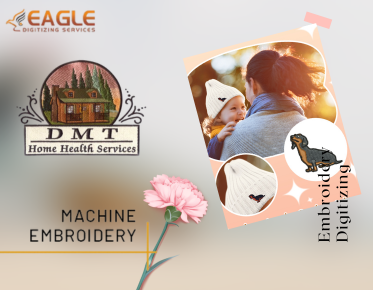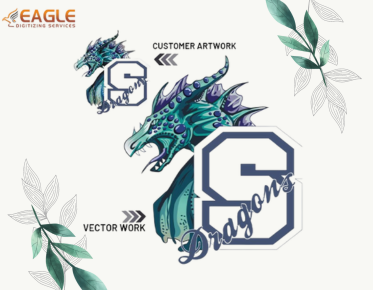How to Prepare Artwork for Embroidery Digitizing Without Hassle
Embroidery digitizing might seem like a
simple concept, but for anyone diving into the world of stitching, it’s an art
form that blends technology with creativity. At its core, embroidery digitizing
is the process of turning artwork into a digital format that an embroidery machine can interpret. It’s a crucial step for anyone
looking to create high-quality embroidered products. Whether you’re a seasoned
designer or just beginning to explore this medium, understanding how to
properly prepare your artwork for digitizing can make the difference between a
flawless finish and a subpar stitch job. This guide is for designers, artists,
and hobbyists who want to ensure their designs are ready to be transformed into
beautiful, stitched pieces.
Choosing the Right Artwork for Embroidery
Not every piece of artwork is suitable for
embroidery. The key to successful embroidery is simplicity and clarity. Designs
that are too complex or contain too many colors can become muddled when
translated into thread. Therefore, it’s essential to choose or modify artwork
that is “embroidery-friendly.” This means opting for designs with clean lines,
solid shapes, and limited color palettes. Complex designs can be simplified by
removing unnecessary details or breaking them down into more manageable
elements. A simplified design not only embroiders more cleanly but also allows
the essence of your artwork to shine through.
File Formats: What You Need to Know
The file format of your artwork is crucial when
preparing for embroidery digitizing. The most commonly used formats include
PNG, JPEG, and SVG. However, vector files (such
as AI or EPS) are often preferred because they can be resized without losing
quality. Converting your artwork to the appropriate format is a necessary step,
as it ensures the embroidery software can properly read and process the design.
Raster images, like JPEGs or PNGs, are made up of pixels, which can become
blurry when scaled, while vector images are composed of paths that remain sharp
at any size, making them ideal for embroidery.
Design Size Matters
Size plays a pivotal role in how well your
artwork translates into embroidery. A design that’s too large or too small can
affect the final quality. When resizing your artwork, it’s important to
maintain the correct proportions to avoid distortion. Additionally,
understanding stitch density – how closely stitches are placed together – is essential.
Higher stitch density can make a design appear more solid, but it can also
cause the fabric to pucker if not balanced correctly with the fabric type and
size of the design. Therefore, careful consideration is needed to ensure that
your design is resized appropriately while maintaining its integrity.
Color Considerations
Managing colors in your design is another
critical aspect of embroidery preparation. Unlike digital or print media, where
a vast range of colors is available, embroidery relies on thread colors, which
are more limited. Simplifying your color palette can help avoid issues during
the digitizing process. It’s also important to consider how your chosen thread
colors will appear on the fabric. Sometimes, a color that looks great on screen
might not have the same impact when stitched. Matching your thread colors
closely to your artwork’s colors is essential to ensure the final product looks
as intended.
Outline and Details: What Stands Out in Embroidery
Strong outlines are the backbone of many embroidery designs. They help define shapes and ensure
the design’s key elements stand out. However, fine details in a design can
sometimes get lost during the embroidery process, especially if the design is
too intricate. Adjusting line thicknesses and simplifying overly detailed areas
can prevent this loss of detail. It’s important to remember that what looks
good on paper or screen might not translate perfectly to thread, so modifying
your design to enhance bold outlines and minimize tiny details can lead to a
better-embroidered product.
Choosing the Right Stitch Types
The type of stitches used in embroidery can
drastically alter the appearance of your design. There are several stitch types
to choose from, each offering a different effect. Satin stitches, for instance,
are ideal for creating smooth, shiny surfaces, while fill stitches are perfect
for covering larger areas with a textured look. The choice between these and
other stitch types depends on the desired outcome and the nature of your design.
For example, smaller details might benefit from a satin stitch, while larger
areas might look better with a fill stitch. Selecting the appropriate stitch
type is essential to achieve the desired aesthetic.
Handling Text in Embroidery Designs
Text can be challenging in embroidery, especially
when it’s small or intricate. Best practices include choosing a font that’s
clear and legible when stitched. Avoid overly decorative fonts that might lose
their clarity when reduced in size. Additionally, the spacing between letters
(kerning) should be sufficient to prevent them from blending into each other.
It’s also important to consider the size of the text – if it’s too small, it
may not embroider well, leading to a loss of readability. Ensuring that text is
clean and well-defined will make a significant difference in the final product.
Avoiding Common Design Mistakes
When preparing artwork for embroidery, certain
mistakes are easy to make but can have a big impact on the final outcome. One
common issue is gaps in the embroidery, which can occur if the design is too
complex or the stitch density isn’t properly adjusted. Overly detailed designs
can also be problematic, as they might not translate well into thread, leading
to a muddled appearance. Negative space – the empty areas around or within a
design – should be carefully considered, as too much or too little can affect
the design’s balance and clarity. By avoiding these pitfalls, you can ensure a
cleaner and more professional-looking embroidered piece.
Optimizing Your Design for Different
Fabrics
The type of fabric you’re embroidering on can
greatly influence how your design turns out. Different fabrics interact with
stitches in various ways, and what works well on one material might not work on
another. For instance, stretchy fabrics like jerseys require a different
approach than rigid fabrics like canvas. Adjusting your artwork to accommodate
the texture and flexibility of the fabric is crucial. It’s also wise to test
your design on the fabric type you plan to use, as this will give you a better
idea of how the final product will look and allow you to make necessary
adjustments.
Preparing Multi-Layered Designs
Layered designs can add depth and dimension to
your embroidery, but they require careful planning. Proper layering ensures
that each element of the design sits correctly without creating unnecessary
bulk or overlap. Managing overlaps in embroidery is key to avoiding issues like
fabric puckering or misaligned stitches. By carefully considering the order in
which the elements of your design are stitched, you can achieve a clean and
professional finish. This step is particularly important for complex designs
that involve multiple colors or elements, as poor layering can result in a
cluttered or uneven final product.
Understanding Embroidery Hoops and Placement
Embroidery hoops play a vital role in the overall
success of your project. They keep the fabric taut and ensure that the design
is stitched in the correct position. The placement of your design within the hoop
is equally important; a misaligned design can lead to a crooked or off-center
final product. Tips for centering and aligning your artwork include using
alignment tools and marking your fabric before hooping it. By paying close
attention to hoop placement, you can ensure that your design is properly
positioned, leading to a more polished and professional result.
Finalizing Your Artwork Before Digitizing
Before sending your artwork off for digitizing, it’s essential to give it a final
once-over. This checklist should include reviewing the design for any stray
marks, ensuring all lines are clean and crisp, and verifying that the design is
the correct size and format. Cleaning up your design can make a big difference
in the quality of the final embroidery, as any imperfections in the artwork
will likely be magnified when stitched. Additionally, preparing a
high-resolution file for digitizing is crucial, as this will ensure that all
details are captured accurately during the digitizing process.
Working with a Professional Embroidery Digitizer
If you’re not comfortable with the digitizing
process or want to ensure the best possible outcome, working with a
professional digitizer is a smart move. A skilled digitizer can take your
artwork and translate it into a file that’s optimized for embroidery, taking
into account factors like stitch types, density, and fabric type. To get the
best results, it’s important to communicate your vision clearly with the
digitizer, providing them with as much detail as possible about your design and
how you want it to look. Reviewing the digitized design before production is
also essential, as it allows you to make any necessary adjustments before
committing to the final product.
Testing Your Design
Testing your design is a crucial step that
shouldn’t be overlooked. A test run allows you to see how your design will look
when embroidered, giving you the opportunity to spot any flaws or areas that
need adjustment. Analyzing the test embroidery for issues like misaligned
stitches, gaps, or color mismatches will help you make informed decisions about
any changes that need to be made. This step can save you a lot of time and
frustration, as it allows you to perfect your design before starting full
production.
Tools and Software for DIY Digitizing
For those interested in doing their own digitizing, there are several software options available that cater to different skill levels. Popular choices for beginners include software with auto-digitizing features, which can simplify the process by automatically converting artwork into a stitch file. However, manual digitizing, where you have full control over every stitch, can offer better results for complex designs. The choice between manual and auto-digitizing depends on your comfort level and the specific needs of your project. Understanding the pros and cons of each approach will help you make an informed decision about which method to use.
Common Issues and How to Fix Them
Even with the best preparation, issues can arise
during the embroidery process. Troubleshooting stitching problems, such as
thread breaks, tension issues, or uneven stitching, is part of the process. If
your design doesn’t look right, it’s important to diagnose the problem and make
the necessary adjustments. Quick fixes for common issues include adjusting
stitch density, changing thread types, or modifying the design to reduce
complexity. By addressing these issues promptly, you can ensure a smoother
embroidery process and a higher-quality final product.
Preparing artwork for embroiderydigitizing in USA is a complex process that needs close attention to detail and a thorough understanding of how designs transform into thread. By following the tips and techniques outlined in this guide, you can enhance the quality of your embroidered designs and create products that truly stand out. Don’t be afraid to experiment and learn from each project – with time and practice, your skills in preparing artwork for embroidery will only improve. As you continue to refine your process, you’ll find that the possibilities for creating beautiful embroidered pieces are endless.



